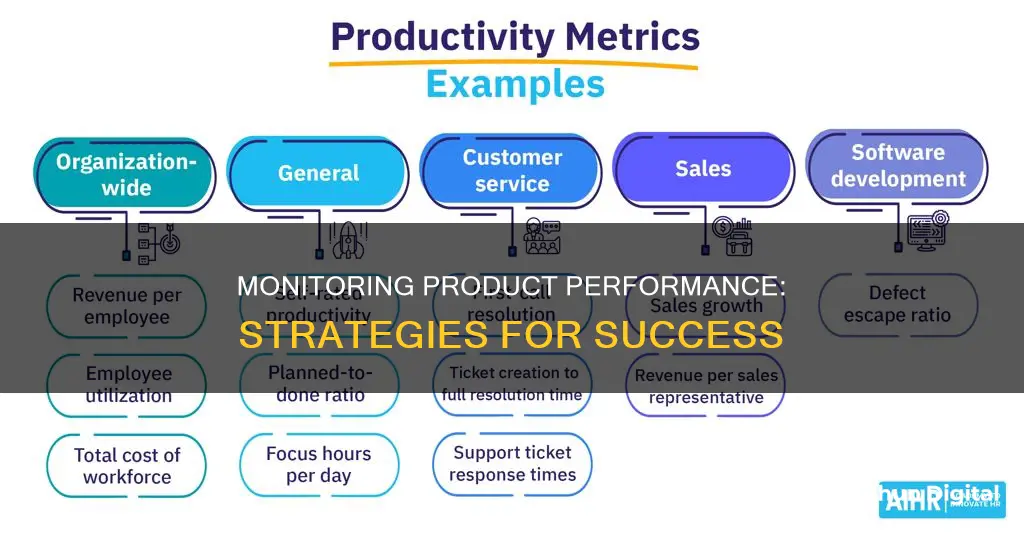
Monitoring product performance is essential for product management. It involves evaluating and measuring a product's effectiveness, usage, and impact using various analytics tools. This process provides deep insights into user interactions, highlighting strengths and areas for improvement, and enabling data-driven decisions. By defining clear goals and tracking key metrics, businesses can enhance their product's performance and stay competitive. This includes analysing user behaviour, customer satisfaction, sales trends, and marketing performance. Ultimately, product performance measurement allows companies to make informed decisions, allocate resources effectively, and improve their products to meet customer needs and business objectives.
What You'll Learn

Customer satisfaction
- Surveys: One of the most common methods of measuring customer satisfaction is through surveys. These can include multiple-choice questions, rating questions, and open-ended questions. Surveys can be distributed at various points in the customer journey and can be customized to fit your brand and goals.
- Net Promoter Score (NPS): NPS measures customer loyalty by asking customers how likely they are to recommend your product or service to others. A high NPS indicates strong customer advocacy, which can lead to organic growth.
- Customer Satisfaction Score (CSAT): CSAT measures the level of satisfaction or dissatisfaction with your product or service. Customers rate their satisfaction on a scale, usually from 1-5 or 1-7. A high CSAT score indicates happy customers who are likely to remain loyal and continue doing business with you.
- Customer feedback: Collecting and analyzing customer feedback is crucial for understanding their level of satisfaction. This can be done through reviews, social media comments, and survey responses. By listening to your customers and addressing their concerns, you can make informed decisions to improve your product or service.
- Sentiment analysis: This involves analyzing customer feedback to determine their overall satisfaction and identify areas for improvement. Sentiment analysis can help you gauge customers' feelings about your product, brand, and their likelihood to recommend it to others.
- Retention and churn rate: Monitoring customer retention and churn rates can provide insights into customer satisfaction. A high retention rate indicates satisfied customers who continue doing business with you, while a high churn rate may signal dissatisfaction.
- Customer loyalty: Loyal customers are likely to be satisfied with your product or service and may serve as brand advocates. Measuring customer loyalty can help you understand the emotional connection they have with your brand and their willingness to recommend it to others.
By monitoring these metrics and analyzing customer feedback, you can gain valuable insights into your customers' satisfaction and make data-driven decisions to improve your product and overall customer experience.
Choosing the Right Studio Monitor Size for Your Setup
You may want to see also

Customer retention
- It is cheaper to retain customers than acquire new ones.
- Loyal customers tend to spend more money and buy your products regularly.
- Happy customers are likely to share their good experiences with others, acting as a compelling force for your business.
- Loyal customers can provide valuable feedback to enhance your business performance and lead to increased retention rates and sales.
- Customer retention rate = (number of customers at the end of a given time period – number of new customers)/number of customers at the beginning of that time period
- Customer churn rate = (number of customers at the start of the period – number of customers at the end of the period + new customers)/number of customers at the start of the period
- Monthly customer churn rate = (number of customers churned in a month/total number of customers at the start of the month) x 100
- Customer lifetime value = total revenue a customer generates throughout their relationship with your company
- Net Promoter Score = measure of customer loyalty and satisfaction. Customers are asked to rate their likelihood of recommending your product to others on a scale of 0 to 10.
- Customer Satisfaction Score = measure of how satisfied your customers are with your product or service. Customers are typically asked to rate their satisfaction on a scale.
- Personalize the onboarding process for new customers to shorten the time to value.
- Loyalty programs and incentives can encourage users to stick around.
- Upgrade prompts can be used to encourage users to stick with your product.
- Secondary onboarding can help clients become more familiar with new features and relate them to their use cases.
- Develop engaging user experiences and improve feature adoption rates.
- Offer incentives, discounts, and small rewards to encourage repeat purchases and build loyalty.
- Prompt customers to upgrade their accounts using tooltips, modals, banners, or emails.
- Collect direct responses from users about what aspects of your product need improvement.
- In-app messaging and email campaigns can be used to re-engage customers and remind them of the value of your product.
- Provide great customer service.
Microchipping: Ankle Monitoring's Interfering Future?
You may want to see also

Product usage
How to Measure Product Usage
When measuring product usage, it is important to avoid vanity metrics. For instance, the number of logins per day does not tell you anything about the usage of your product. Instead, you should focus on metrics that give you valuable insights into how your product is growing and how your users are engaging with it. Here are some examples:
- Product Onboarding Engagement Rate: This measures how many users engage with your in-app onboarding.
- Product Activation Rate: This accounts for the number of users reaching the activation point in the user journey, which is when the user discovers the product's value.
- Number of Key User Actions per Session: This takes into account your product's core action usage. For example, if your product is an email marketing automation tool, your product core usage key actions might be scheduling an email automation campaign, checking email campaign performance, and tweaking email campaigns.
- Customer Engagement Score: This assigns a number that denotes the level of engagement of your customers and free trial prospects. Each customer gets a score based on how they are using your product.
- Feature Usage: This offers an in-depth view of how your product is being used by looking at the number of users utilizing a specific feature.
- Product Usage Stickiness: This is your daily active users divided by your monthly active users. It can be used to identify your product's natural cadence and the users showing the most stickiness.
Tools for Tracking Product Usage Metrics
When choosing a tool for tracking product usage metrics, consider your product and user data needs. Some tools that can be used include:
- Userpilot: Allows you to build and deliver contextual in-app experiences for your users and provides product usage analytics.
- Heap: A standalone comprehensive product analytics suite.
- FullStory: Tracks all user interactions without configuration and provides session recording.
- Mixpanel: Offers a vast array of capabilities for tracking and collating user data, particularly real-time data.
- Iteratively: Allows you to combine all your other data sources in one place.
Benefits of Monitoring Product Usage
Monitoring product usage provides valuable insights into user interactions, highlighting strengths and areas for improvement. It enables data-driven decisions and strategies to improve user engagement and customer satisfaction. Additionally, it helps identify user behaviour patterns and preferences, allowing businesses to create experiences that truly resonate with their customers.
God's Ankle Monitor: A Divine House Arrest?
You may want to see also

Marketing ROI
While the calculation of Marketing ROI may seem straightforward, there are nuances to consider. For instance, certain investments might not have a direct link to leads or revenue, such as awareness campaigns. In such cases, alternative methods for calculating Marketing ROI may be necessary.
One approach is to assess the amount of leads generated per dollar invested. This method acknowledges that not all leads will convert into customers, but it provides a metric to evaluate the effectiveness of marketing activities in generating interest.
Another approach is to calculate the revenue earned per dollar invested. This method goes beyond lead generation and considers the entire sales funnel, including the conversion of leads into customers and the resulting revenue.
Furthermore, it is important to compare marketing activities and deploy only the most successful ones. This involves analysing multiple campaigns and identifying those with the highest Marketing ROI. By focusing resources on the most effective strategies, businesses can optimise their marketing efforts and improve overall product performance.
In addition to Marketing ROI, there are other key metrics that contribute to a comprehensive understanding of product performance. These include Customer Acquisition Cost (CAC), which evaluates the efficiency of customer acquisition strategies, and Customer Retention Rate, which provides insights into customer loyalty and satisfaction. By tracking a range of metrics, businesses can make data-driven decisions to enhance their products and better meet customer needs.
Understanding Monitor Types: LED vs LCD Displays
You may want to see also

Product performance analytics
- It provides insights into where strategies are succeeding and where they need improvement.
- It helps businesses understand how customers interact with the product.
- It identifies which features are used most and which may need to be redesigned.
- It is useful for sales trend analysis and customer retention analysis.
- It can increase customer satisfaction and improve the customer journey.
- It is necessary for marketing funnel analysis.
How to Measure Product Performance
- Define your goals: These can vary and may involve different aspects of your business, such as increasing purchases, enhancing user experience, improving conversion rates, and reducing abandonment rates.
- Track key metrics: These include Customer Satisfaction Score (CSAT), churn rate, customer retention rate, feature and product usage, average revenue per user (ARPU), social media and non-social reach, and the volume of mentions.
- Use analytics tools: Sentiment analysis, heatmaps, cohort analysis, and analytics dashboards can be used to track key performance indicators (KPIs).
- Analyse the results: Uncover valuable insights about the product's performance and identify areas for improvement.
- Implement insights: Turn actionable insights into marketing strategies by improving user engagement and customer satisfaction.
- Continuously measure and adapt: Regularly review goals, metrics, and strategies to ensure the product adapts to changing user needs and market conditions.
Benefits of Product Performance Analytics
- Improved user experience: Data-driven design and feature enhancements lead to a better user experience.
- Increased customer retention: Addressing pain points and enhancing satisfaction leads to higher retention rates.
- Better resource allocation: Identifying high-impact areas allows for better allocation of development resources.
- Enhanced decision-making: Real-time performance insights enable more informed strategic decisions.
- Optimised marketing strategies: User behaviour and engagement data inform and optimise marketing approaches.
- Proactive issue resolution: Monitoring performance trends helps identify and address issues promptly.
The Best HDMI-Enabled LCD Monitors for Your Setup
You may want to see also
Frequently asked questions
Monitoring product performance provides insights into where your strategies are succeeding and where they need work. It allows you to identify areas for improvement, make accurate forecasts, and allocate resources effectively.
To measure product performance, you need to collect data on product usage and customer behaviour. This can be done through analytics tools such as sentiment analysis, heatmaps, cohort analysis, and analytics dashboards.
Some key metrics include customer acquisition cost, trial sign-up rate, activation rate, customer retention rate, customer satisfaction score, net promoter score, and monthly recurring revenue.
Product performance analytics can help identify which features are used most and which may need to be redesigned. It can also help improve the customer journey by optimising the user experience and addressing issues that may cause customers to abandon the product.







